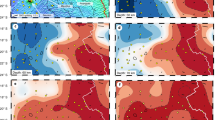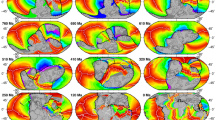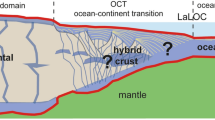Abstract
Volcanic hotspot tracks featuring linear progressions in the age of volcanism are typical surface expressions of plate tectonic movement on top of narrow plumes of hot material within Earth’s mantle1. Seismic imaging reveals that these plumes can be of deep origin2—probably rooted on thermochemical structures in the lower mantle3,4,5,6. Although palaeomagnetic and radiometric age data suggest that mantle flow can advect plume conduits laterally7,8, the flow dynamics underlying the formation of the sharp bend occurring only in the Hawaiian–Emperor hotspot track in the Pacific Ocean remains enigmatic. Here we present palaeogeographically constrained numerical models of thermochemical convection and demonstrate that flow in the deep lower mantle under the north Pacific was anomalously vigorous between 100 million years ago and 50 million years ago as a consequence of long-lasting subduction systems, unlike those in the south Pacific. These models show a sharp bend in the Hawaiian–Emperor hotspot track arising from the interplay of plume tilt and the lateral advection of plume sources. The different trajectories of the Hawaiian and Louisville hotspot tracks arise from asymmetric deformation of thermochemical structures under the Pacific between 100 million years ago and 50 million years ago. This asymmetric deformation waned just before the Hawaiian–Emperor bend developed, owing to flow in the deepest lower mantle associated with slab descent in the north and south Pacific.
This is a preview of subscription content, access via your institution
Access options
Subscribe to this journal
Receive 51 print issues and online access
$199.00 per year
only $3.90 per issue
Buy this article
- Purchase on Springer Link
- Instant access to full article PDF
Prices may be subject to local taxes which are calculated during checkout



Similar content being viewed by others
References
Morgan, W. J. Convection plumes in the lower mantle. Nature 230, 42–43 (1971)
French, S. W. & Romanowicz, B. Broad plumes rooted at the base of the Earth’s mantle beneath major hotspots. Nature 525, 95–99 (2015)
Jellinek, A. M. & Manga, M. The influence of a chemical boundary layer on the fixity, spacing and lifetime of mantle plumes. Nature 418, 760–763 (2002)
Lin, S.-C. & van Keken, P. E. Dynamics of thermochemical plumes: 2. Complexity of plume structures and its implications for mapping mantle plumes. Geochem. Geophys. Geosyst. 7, Q03003 (2006)
Farnetani, C. Excess temperature of mantle plumes: the role of chemical stratification across D′′. Geophys. Res. Lett. 24, 1583–1586 (1997)
Thorne, M. S., Garnero, E. J. & Grand, S. P. Geographic correlation between hot spots and deep mantle lateral shear-wave velocity gradients. Phys. Earth Planet. Inter. 146, 47–63 (2004)
Tarduno, J. A. et al. The Emperor seamounts: southward motion of the Hawaiian hotspot plume in Earth’s mantle. Science 301, 1064–1069 (2003)
Koppers, A. A. et al. Limited latitudinal mantle plume motion for the Louisville hotspot. Nature Geosci . 5, 911–917 (2012)
Koppers, A. A., Duncan, R. A. & Steinberger, B. Implications of a nonlinear 40Ar/39Ar age progression along the Louisville seamount trail for models of fixed and moving hot spots. Geochem. Geophys. Geosyst. 5, Q06L02 (2004)
Hassan, R., Flament, N., Gurnis, M., Bower, D. J. & Müller, D. Provenance of plumes in global convection models. Geochem. Geophys. Geosyst. 16, 1465–1489 (2015)
Bower, D. J., Gurnis, M. & Seton, M. Lower mantle structure from paleogeographically constrained dynamic Earth models. Geochem. Geophys. Geosyst. 14, 44–63 (2013)
McNamara, A. K. & Zhong, S. Thermochemical structures beneath Africa and the Pacific Ocean. Nature 437, 1136–1139 (2005)
Burke, K., Steinberger, B., Torsvik, T. H. & Smethurst, M. A. Plume generation zones at the margins of large low shear velocity provinces on the core–mantle boundary. Earth Planet. Sci. Lett. 265, 49–60 (2008)
Torsvik, T. H. et al. Deep mantle structure as a reference frame for movements in and on the Earth. Proc. Natl Acad. Sci. USA 111, 8735–8740 (2014)
Steinberger, B., Sutherland, R. & O’Connell, R. J. Prediction of Emperor–Hawaii seamount locations from a revised model of global plate motion and mantle flow. Nature 430, 167–173 (2004)
Wright, N. M., Müller, R. D., Seton, M. & Williams, S. E. Revision of paleogene plate motions in the Pacific and implications for the Hawaiian-Emperor bend. Geology 43, 455–458 (2015)
Tarduno, J., Bunge, H.-P., Sleep, N. & Hansen, U. The bent Hawaiian-Emperor hotspot track: inheriting the mantle wind. Science 324, 50–53 (2009)
Tarduno, J. A. On the motion of Hawaii and other mantle plumes. Chem. Geol. 241, 234–247 (2007)
Bower, D. J., Gurnis, M. & Flament, N. Assimilating lithosphere and slab history in 4-D Earth models. Phys. Earth Planet. Inter. 238, 8–22 (2015)
Garnero, E. J. & McNamara, A. K. Structure and dynamics of Earth’s lower mantle. Science 320, 626–628 (2008)
Lay, T., Williams, Q. & Garnero, E. J. The core–mantle boundary layer and deep Earth dynamics. Nature 392, 461–468 (1998)
van der Meer, D. G., Spakman, W., van Hinsbergen, D. J., Amaru, M. L. & Torsvik, T. H. Towards absolute plate motions constrained by lower-mantle slab remnants. Nature Geosci . 3, 36–40 (2010)
Steinberger, B. & Calderwood, A. R. Models of large-scale viscous flow in the Earth’s mantle with constraints from mineral physics and surface observations. Geophys. J. Int. 167, 1461–1481 (2006)
van Keken, P. E., Yuen, D. A. & van den Berg, A. P. Implications for mantle dynamics from the high melting temperature of perovskite. Science 264, 1437–1439 (1994)
Olson, P., Schubert, G. & Anderson, C. Plume formation in the D′′-layer and the roughness of the core–mantle boundary. Nature 327, 409–413 (1987)
Steinberger, B. Plumes in a convecting mantle: models and observations for individual hotspots. J. Geophys. Res. Solid Earth 105, 11127–11152 (2000)
Montelli, R. et al. Finite-frequency tomography reveals a variety of plumes in the mantle. Science 303, 338–343 (2004)
Zhong, S. & Rudolph, M. L. On the temporal evolution of long-wavelength mantle structure of the Earth since the early Paleozoic. Geochem. Geophys. Geosyst. 16, 1599–1615 (2015)
Portnyagin, M., Savelyev, D., Hoernle, K., Hauff, F. & Garbe-Schönberg, D. Mid-Cretaceous Hawaiian tholeiites preserved in Kamchatka. Geology 36, 903–906 (2008)
Torsvik, T. H., Steinberger, B., Cocks, L. R. M. & Burke, K. Longitude: linking Earth’s ancient surface to its deep interior. Earth Planet. Sci. Lett. 276, 273–282 (2008)
Christensen, U. R. & Yuen, D. A. Layered convection induced by phase transitions. J. Geophys. Res. 90, 10291–10300 (1985)
Zhong, S., McNamara, A., Tan, E., Moresi, L. & Gurnis, M. A benchmark study on mantle convection in a 3-D spherical shell using CitcomS. Geochem. Geophys. Geosyst. 9, Q10017 (2008)
Tosi, N., Yuen, D. A., de Koker, N. & Wentzcovitch, R. M. Mantle dynamics with pressure- and temperature-dependent thermal expansivity and conductivity. Phys. Earth Planet. Inter. 217, 48–58 (2013)
Karato, S.-I. & Wu, P. Rheology of the upper mantle: a synthesis. Science 260, 771–778 (1993)
Tackley, P. J. Effects of strongly variable viscosity on three-dimensional compressible convection in planetary mantles. J. Geophys. Res. 101, 3311–3332 (1996)
Seton, M. et al. Global continental and ocean basin reconstructions since 200Ma. Earth Sci. Rev. 113, 212–270 (2012)
Shephard, G. E., Müller, R. D. & Seton, M. The tectonic evolution of the Arctic since Pangea breakup: integrating constraints from surface geology and geophysics with mantle structure. Earth Sci. Rev. 124, 148–183 (2013)
Steinberger, B. & Torsvik, T. H. Absolute plate motions and true polar wander in the absence of hotspot tracks. Nature 452, 620–623 (2008)
McNamara, A. K. & Zhong, S. Thermochemical structures within a spherical mantle: superplumes or piles? J. Geophys. Res. 109, B07402 (2004)
Backus, G. Poloidal and toroidal fields in geomagnetic field modeling. Rev. Geophys. 24, 75–109 (1986)
Auer, L., Boschi, L., Becker, T., Nissen-Meyer, T. & Giardini, D. Savani: a variable resolution whole-mantle model of anisotropic shear velocity variations based on multiple data sets. J. Geophys. Res. 119, 3006–3034 (2014)
Lekic, V., Cottaar, S., Dziewonski, A. & Romanowicz, B. Cluster analysis of global lower mantle tomography: a new class of structure and implications for chemical heterogeneity. Earth Planet. Sci. Lett. 357/358, 68–77 (2012)
Acknowledgements
M.G. was supported by the NSF (awards EAR-1161046 and EAR-1247022). R.D.M. and N.F. were supported by an ARC grant (IH130200012). This research was undertaken with the assistance of resources from the National Computational Infrastructure (NCI), which is supported by the Australian Government.
Author information
Authors and Affiliations
Contributions
R.H. and R.D.M. developed the concept of the study. R.H. and M.G. designed the numerical experiments and developed the technical aspects of the study. All authors contributed both intellectually and to the writing of the paper.
Corresponding author
Ethics declarations
Competing interests
The authors declare no competing financial interests.
Extended data figures and tables
Extended Data Figure 1 Comparison of model LLSVPs with tomography.
The Savani tomography model41, showing shear velocity (vs) perturbations at 2,818 km depth. Contours of the 75% chemical concentration isosurface, at labelled heights above the CMB, show the present-day shapes of the model LLSVPs in case M3 (Extended Data Table 2). The red triangle and purple cross symbols mark the locations of the actual and model Hawaiian plumes at present-day, respectively.
Extended Data Figure 2 Evolution of mean poloidal flow.
In each panel, the magnitude of mean poloidal velocity in a 300-km-thick shell above the CMB is shown in grey shading and corresponding flow directions are shown by black arrows at the age labelled, for case M3 (Extended Data Table 2). Edges of the model LLSVPs are marked by contours of the 75% chemical concentration isosurface, at labelled heights above the CMB. Subduction zones are shown in yellow and the white rectangular region marks the extent of the three-dimensional plots in Extended Data Fig. 3. In the bottom row of each panel, cross-sections along cyan profiles through the Pacific LLSVP show the evolution of its edges driven by subduction-induced flow. Velocity vectors in these cross-sections have been clipped to 6 cm yr−1 and the black contours show 75% chemical concentration.
Extended Data Figure 3 Trajectory of model Hawaiian plume.
Three-dimensional (Cartesian projection of spherical geometry) perspectives showing the southward motion and evolution of tilt for model plume corresponding to Hawaii (Hm) in case M3 (Extended Data Table 2). The black contour marks the 75% chemical concentration isosurface 100 km above the CMB. The temperature field above layer averages, δT, is isosurfaced at a value of 0.1 to delineate plume conduits. The top 200 km of the domain is not rendered, in order to avoid visual clutter.
Extended Data Figure 4 Inter-model comparisons.
a, For case M1 (Extended Data Table 2), the background shading, velocity vectors and subduction zones shown are as described in Fig. 1a. The model plume trajectory for Hawaii (Hm) at a depth of 350 km is coloured by age. b, For case M2. c, For case M4. d, For case M5. e, For case M6. f, For case M7.
Supplementary information
Evolution of mean poloidal flow in the deep lower mantle.
The video shows the evolution of mean poloidal flow in a 300 km thick shell above the core mantle boundary over the last 140 million years. Cross sections along profiles through the Pacific LLSVP show the evolution of its edges driven by subduction-induced flow. (MP4 10037 kb)
Trajectory of modelled Hawaiian plume.
The video shows the southward motion of the modelled Hawaiian plume and the evolution of its tilt. The black contour marks the 75% chemical concentration isosurface 100 km above the core mantle boundary. (MP4 4316 kb)
Rights and permissions
About this article
Cite this article
Hassan, R., Müller, R., Gurnis, M. et al. A rapid burst in hotspot motion through the interaction of tectonics and deep mantle flow. Nature 533, 239–242 (2016). https://doi.org/10.1038/nature17422
Received:
Accepted:
Published:
Issue Date:
DOI: https://doi.org/10.1038/nature17422
This article is cited by
-
Assessing plate reconstruction models using plate driving force consistency tests
Scientific Reports (2023)
-
Progress in the numerical modeling of mantle plumes
Science China Earth Sciences (2023)
-
Assembly of the basal mantle structure beneath Africa
Nature (2022)
-
Slab control on the mega-sized North Pacific ultra-low velocity zone
Nature Communications (2022)
-
Dynamics of the abrupt change in Pacific Plate motion around 50 million years ago
Nature Geoscience (2022)
Comments
By submitting a comment you agree to abide by our Terms and Community Guidelines. If you find something abusive or that does not comply with our terms or guidelines please flag it as inappropriate.



